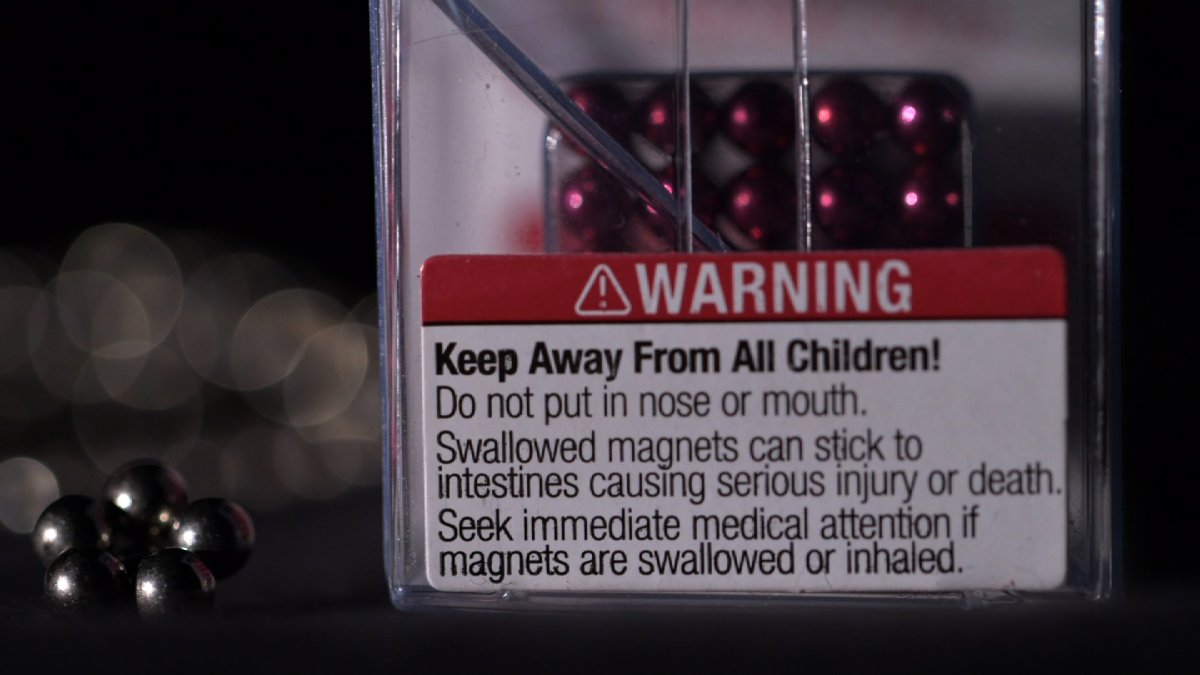TORONTO – Canadian doctors are warning parents to be aware of tiny magnets lying around their homes. While they may seem harmless, the strong magnets have the potential to hurt children if more than one is swallowed.

Children swallowing these small magnets has turned into a disturbing trend.
Data from the Public Health Agency of Canada has even pointed to a significant rise in emergency room visits because of this issue over the past decade.
These aren’t just ordinary magnets, though. They have the potential to severely injure the body if ingested, a new study published Monday in the Canadian Medication Association Journal warns.
Doctors warn that if two are ingested, they could try to connect inside the body and pierce through the gastrointestinal tract.
“It’s like getting shot, like getting a buckshot to the abdomen but without any evidence on the outside,” Dr. Matt Strickland, a pediatric surgical resident at the Hospital for Sick Children told Global News.
“There’s a big danger that parents just don’t know about.”
Because of health concerns, these magnets are already banned in the United States, Australia and New Zealand.
Small magnets packed with strong minerals
As technology improved over the past few decades, so have magnets. They’re no longer fridge magnets that were relatively weak. Now they’re at least twenty times stronger, Strickland said.
They’re also smaller, making it easier for kids to swallow.
These new high-powered magnets – or rare-earth magnets – are made with neodymium-iron-boron. While a conventional magnet would have about four grams of this mineral, these small desk toy magnets contain about 400 grams.
They’re essentially 100 times stronger than a fridge magnet.
These small circular magnets that are sometimes called constructors, are found on fridges, office spaces or in your child’s bedroom.
Magnetic pull could severely injure body internally
That magnetic pull is dangerous, Strickland says. Swallowing one magnet wouldn’t cause harm as it made its way through the body, but once two are swallowed, the danger lies in where they’ll connect.
“Separated in time, you can imagine that they’re geographically separate in the intestinal tract,” Strickland explains.
They could link through the stomach and small intestine, or the small intestine to small intestine or parts of the colon.
“And there they stick. And that pressure that they create between the two of them slowly erodes through the wall of the gastrointestinal tract until you have a hole.
This hole has deadly consequences. As a surgeon, Strickland warns that this intestinal perforation is a major cause of death in patients.
The gap in the intestines can lead to bacterial illness. It can become septic and cause a body-wide infection, Strickland said.
Early detection helps doctors treat young patients
The CMAJ study suggests that if x-rays detect the magnets, they could be removed via endoscopy or a laxative.
But in most cases, it’s hard for doctors or parents to know what’s wrong, especially if the young patient can’t remember if he or she swallowed these magnets.
For Toronto mother Martha, knowing that her three-year-old son Joseph was choking on the magnets made a big difference.
She rushed him to hospital where Strickland helped Joseph. Inside his body, the magnets linked together with the intestinal wall in between.
In other instances, kids may lose their appetite, they’ll start vomiting or other generic symptoms will present themselves. It can be hard to decipher what’s wrong.
Emergency room doctors are then forced to decide to put the child through an x-ray machine or to simply tell their parents to go home and give their sick child bed rest.
“That can lead to some dangerous situations,” Strickland said.
Banning the product and education key to resolution
The small silver magnets can look like toys, or even cake decorations, doctors warn.
And small warnings urging users to keep them away from kids under 14 aren’t sufficient, Strickland says.
“Although there’s a warning on the box, it doesn’t really get across to parents why this is a danger. They think of it as the same danger as any small toys or small parts posed to their children,” Strickland explained.
They don’t understand that the magnets contain dangerous materials if ingested.
Banning the product may halt the movement of these magnets into the country, but they’d still be a commonplace household item.
Strickland suggests that pediatric associations, school boards and parenting groups should step up and echo warnings to parents.




Comments